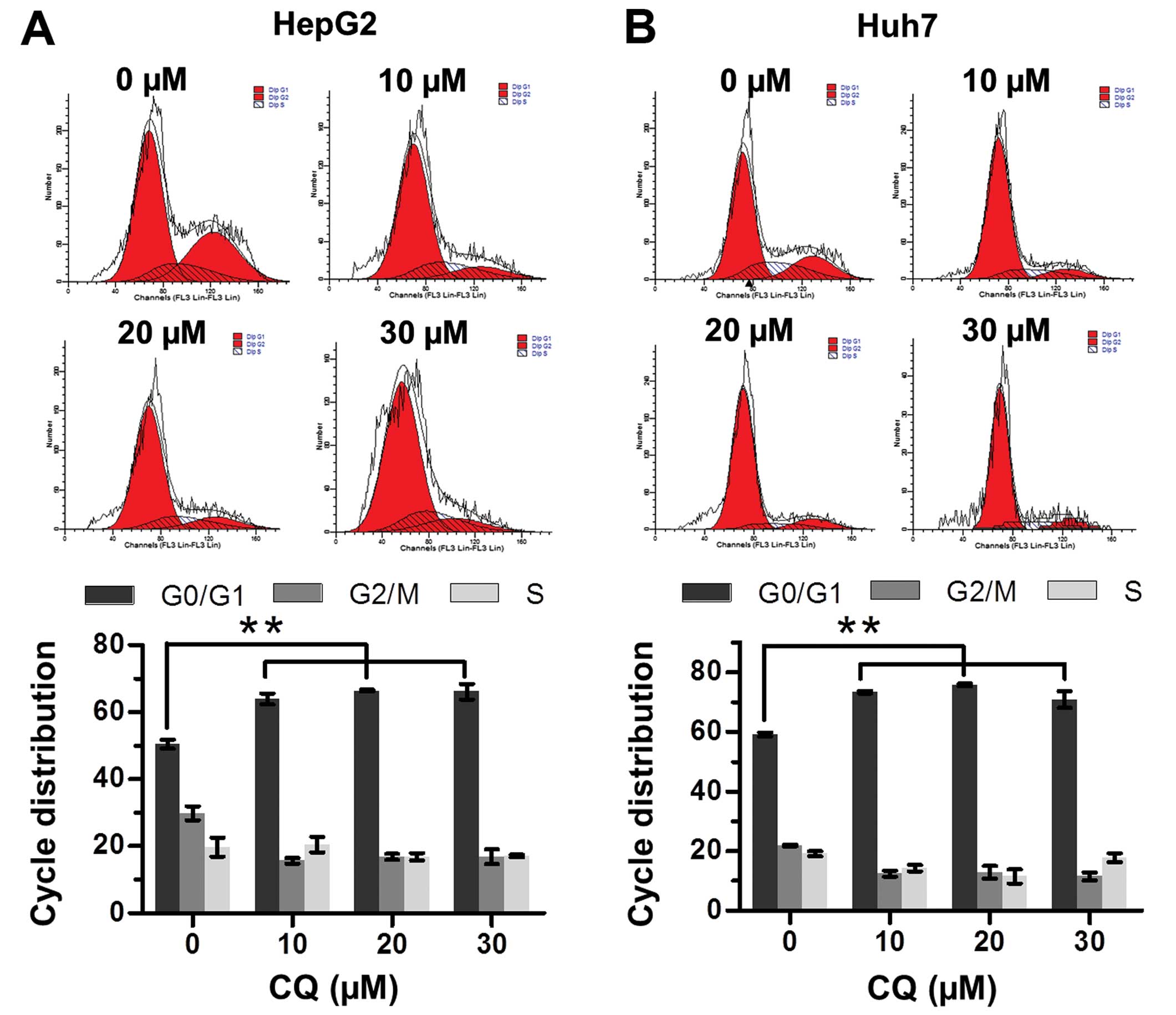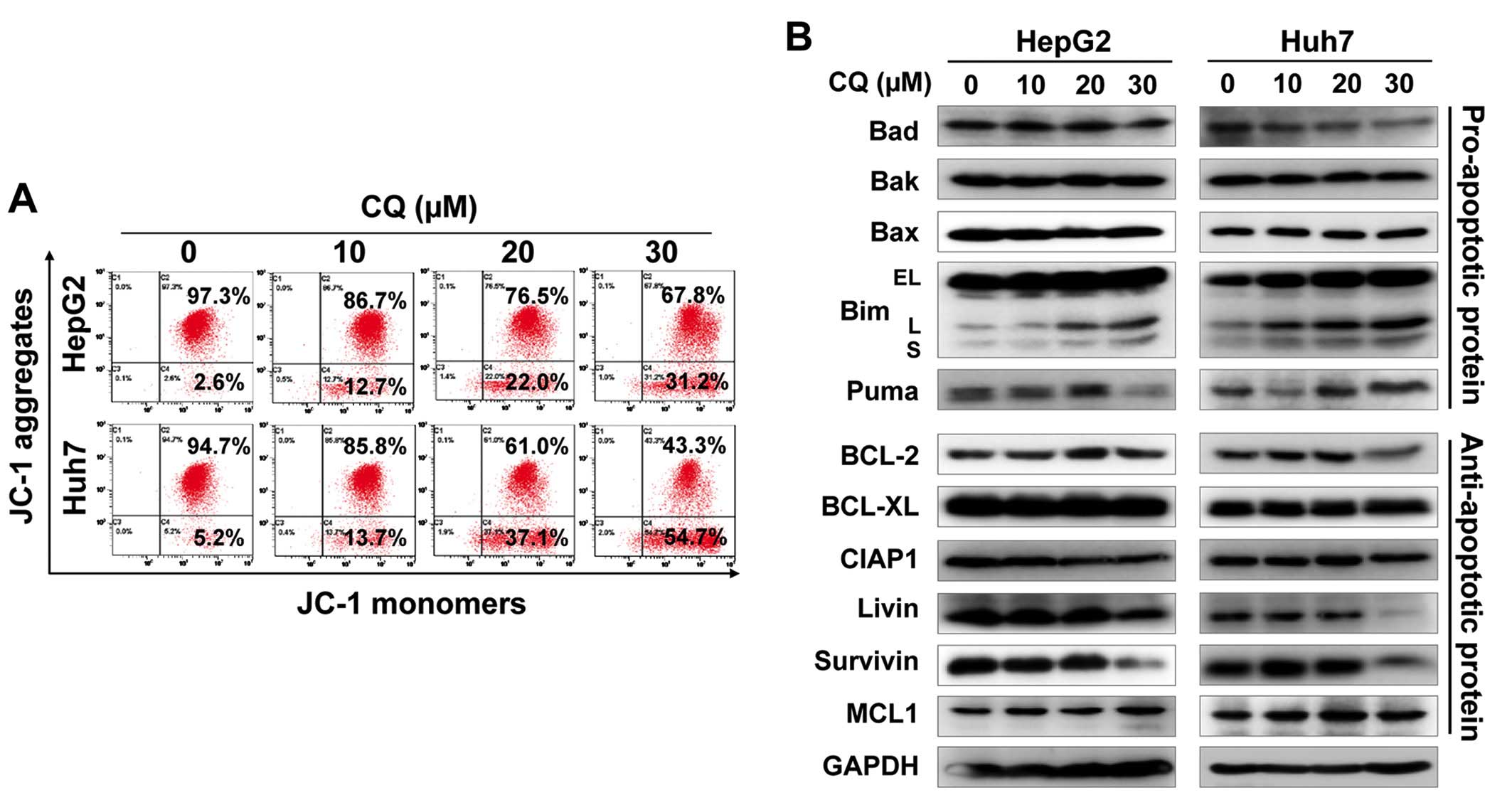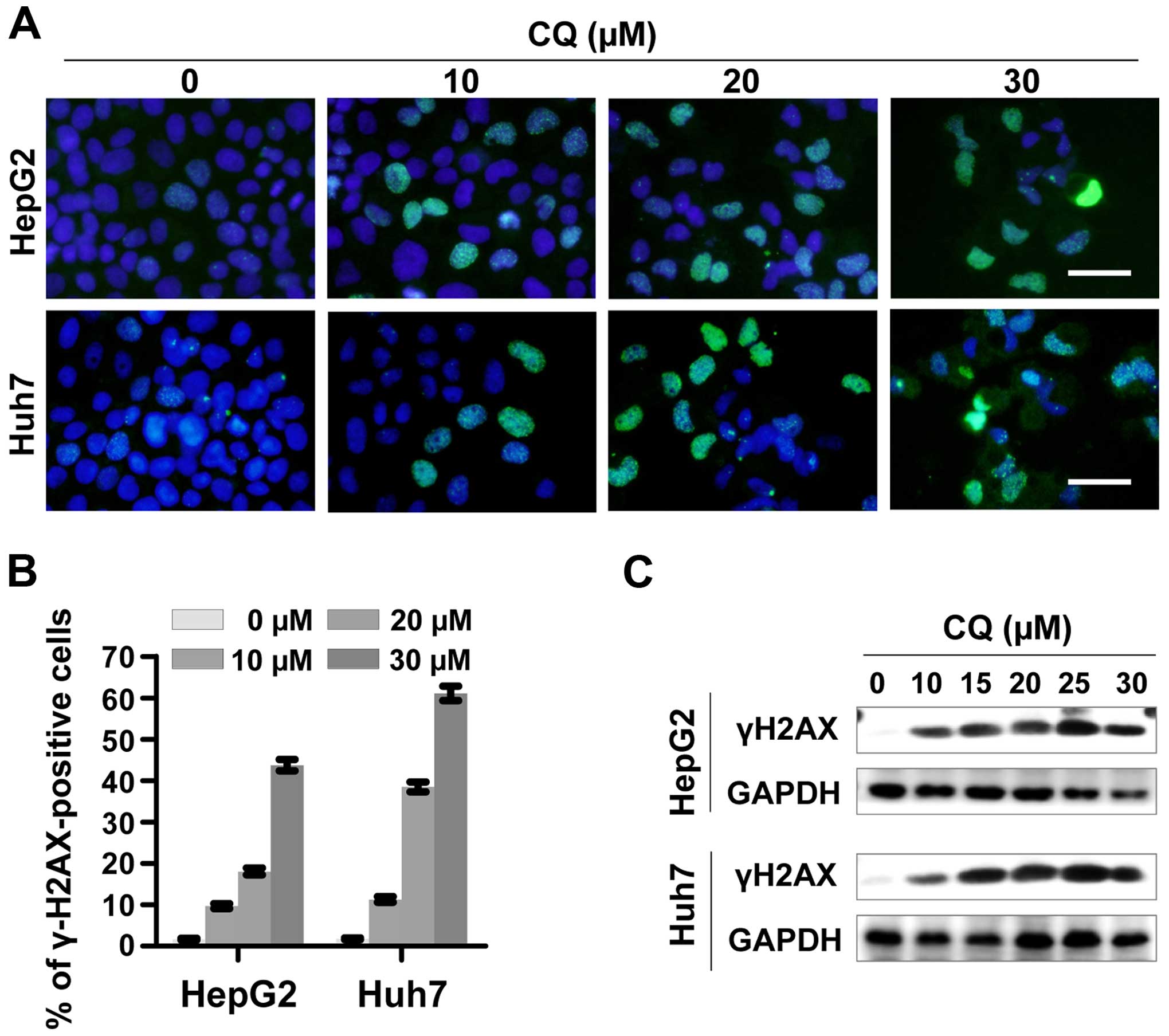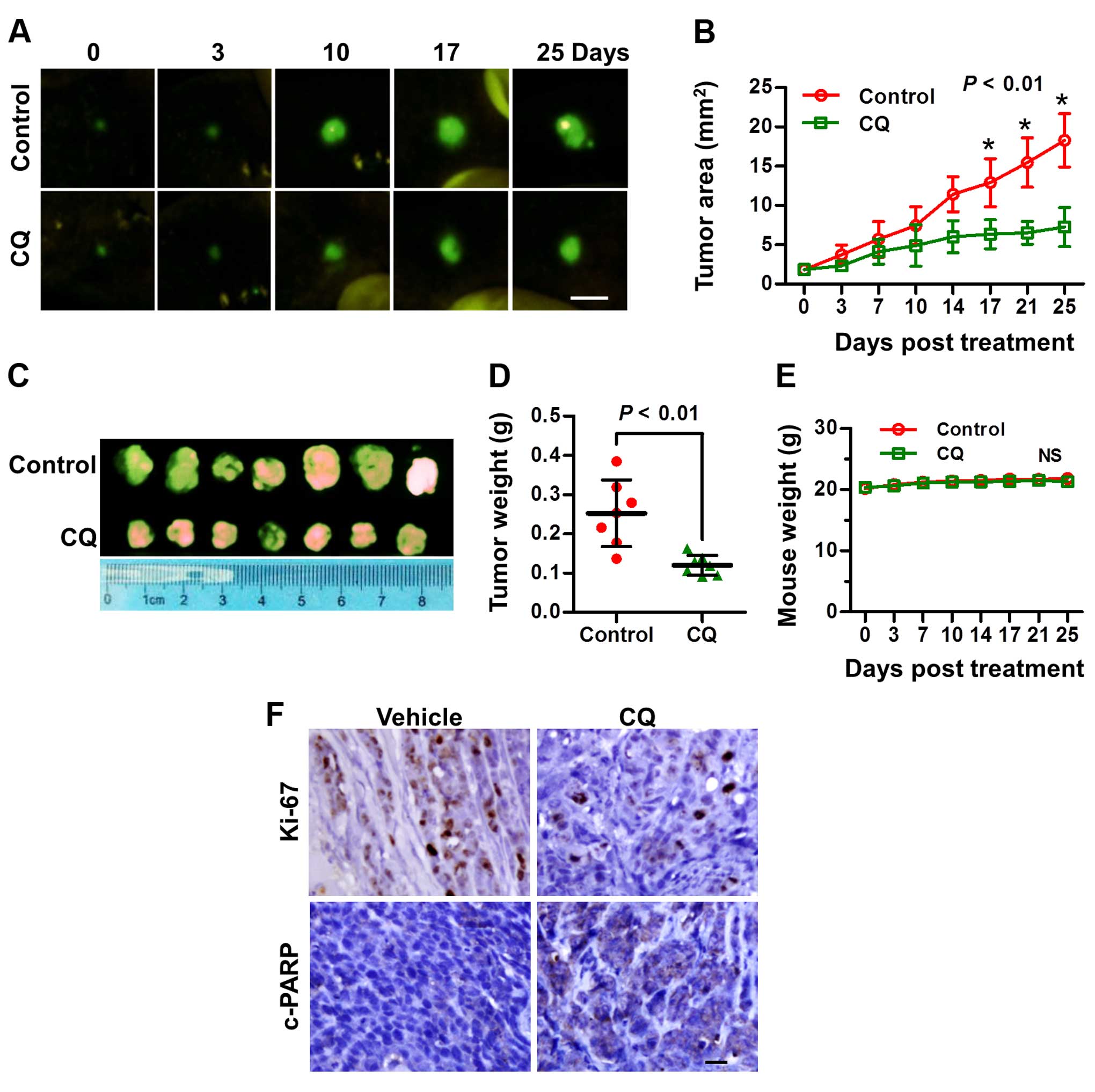Chloroquine inhibits hepatocellular carcinoma cell growth in vitro and in vivo
- Authors:
- Published online on: November 2, 2015 https://doi.org/10.3892/or.2015.4380
- Pages: 43-49
-
Copyright: © Hu et al. This is an open access article distributed under the terms of Creative Commons Attribution License.
Abstract
Introduction
Hepatocellular carcinoma (HCC) is the second most common cause of cancer-related deaths worldwide, with an estimated 782,500 new liver cancer cases and 745,500 related deaths occurring worldwide in 2012 (1). Chemotherapy is a reasonable treatment option for patients with advanced HCC. However, traditional chemotherapy has shown modest efficacy with severe side-effects. Therefore, it is necessary to identify new agents or therapeutic strategies to improve the treatment of liver cancer. One of the important methods is to understand the detailed effect of traditional drugs for drug repositioning (2).
Chloroquine (CQ) is a classic drug for the treatment of malarial (3). Recently, CQ has been widely used as an enhancing agent in cancer therapies and has a synergistic effect with ionizing radiation or chemotherapeutic agents in a cancer-specific manner (4–9). In addition, CQ was reported to inhibit cell growth and/or induce cell death in several tumor models (10–13), and showed lower toxicity to non-tumorigenic epithelial cells (14). However, the effects of single treatment of CQ on liver cancer have not been investigated.
In the present study, we examined the effects of CQ on the growth and viability of liver cancer cells in vitro and in vivo, and revealed that in vitro treatment of liver cancer cells with CQ inhibited cell proliferation and viability, induced G0/G1 cell cycle arrest, DNA damage and apoptosis with upregulation of pro-apoptotic protein Bim. Moreover, administration of CQ to tumor-bearing mice inhibited the tumor growth in an orthotopic xenograft model of liver cancer.
Materials and methods
Cell lines, culture and reagents
Human liver cancer cell lines HepG2 and Huh7 were cultured in Dulbecco's modified Eagle's medium (DMEM) (HyClone), and were supplemented with 10% fetal bovine serum (FBS) (Biochrom AG) at 37°C with 5% CO2. CQ was purchased from Sigma-Aldrich and was dissolved in phosphate-buffered saline (PBS).
Cell proliferation and clonogenic assays
HepG2 and Huh7 cells were seeded into 96-well plates (2.5×103 cells/well) and were treated with different concentrations of CQ as indicated for 24, 48 or 72 h. Cell proliferation was determined using the ATPLite Luminescence assay kit (Perkin-Elmer) according to the manufacturer's protocol. Cell Counting Kit-8 (CCK-8) (Dojindo) was used to quantify drug-induced cytotoxicity as follows. Cells were seeded in 96-well plates, exposed to different concentrations of CQ for 72 h and were then treated with CCK-8 reagent for assessment of cytotoxicity.
For the clonogenic assay, cells were seeded into 6-well plates with 500 cells/well in triplicate, treated with the indicated concentrations of CQ for 24 h, and then washed with PBS twice, followed by incubation for 9 days. The colonies formed were fixed, stained and counted. Colonies with >50 cells were counted.
Western blotting
HepG2 and Huh7 cell lysates treated with CQ were prepared for western blot analysis, using antibodies against cleaved caspase-3, cleaved poly(ADP-ribose) polymerase (PARP), the Pro-Apoptosis Bcl-2 Family Antibody Sampler Kit, the Pro-Survival Bcl-2 Family Antibody Sampler kit, IAP Family Antibody Sampler kit and glyceraldehyde-3-phosphate dehydrogenase (GAPDH) (Cell Signaling, Boston, MA, USA).
Cell cycle analysis
Cells treated with CQ at the indicated concentrations were harvested, fixed in 70% ethanol at −20°C, and were then stained with propidium iodide (PI; 50 µg/ml) containing RNase A (30 µg/ml) (both from Sigma) at 37°C for 30 min. The cells were then analyzed for cell cycle profile by flow cytometry (FACScan; Becton-Dickinson). Data were analyzed with ModFit LT software (verity).
Apoptosis assay
HepG2 and Huh7 cells were treated with CQ for 72 h. Apoptosis was determined with the Annexin V-FITC/PI apoptosis kit (Biovision, Inc. Milpitas, CA, USA) as per the manufacturer's instructions. The early apoptotic (Annexin V-FITC-positive) and necrotic/late apoptotic (Annexin V-FITC-positive, PI-positive) cells were quantified as apoptotic cells. Caspase-3 activity was assessed by the CaspGLOW Fluorescein Active Caspase-3 Staining kit (Biovision, Inc.) according to the manufacturer's instructions.
Evaluation of mitochondrial membrane depolarization
HepG2 and Huh7 cells were treated with CQ at the indicated concentrations. Mitochondrial membrane depolarization was detected with the mitochondrial membrane potential assay kit with JC-1 according to the manufacturer's protocol (Yeasen Inc., Shanghai, China). The data were acquired and analyzed by flow cytometry as previously described (15).
Immunofluorescence
HepG2 and Huh7 cells were plated on chamber slides and treated with CQ for 36 h. Cells were fixed with 4% paraformaldehyde, permeabilized using 0.2% Triton X-100, and incubated overnight with the γ-H2AX antibody (Cell Signaling). Goat anti-rabbit Alexa 488 fluorescent secondary antibody was used to visualize γ-H2AX foci, and DAPI was used to visualize the nuclei.
Antitumor effect of CQ in vivo
An orthotopic xenograft model of liver cancer was established by AntiCancer Biotech as previously described (15). Briefly, HepG2-GFP human liver cancer tissues that originated from subcutaneous tumors of nude mice were harvested and carefully inspected to remove necrotic tissue. The harvested tumor tissues were then equally divided into small pieces of 1 mm3 each. One 1-mm piece of the above tumor tissue fragments was inserted into the incision of the liver of each mouse. The tumor-bearing mice were randomized into 2 groups (7 mice/group) and treated with PBS or CQ (80 mg/kg, s.c.), twice a day respectively, on a 3-day-on/2-day-off schedule for 25 days. Tumor growth was observed, and the tumor area was recorded twice a week with a Fluorvivo Model-300 imaging system as previously described (16,17). Briefly, whole-body images of each mouse were obtained with a Fluorvivo Model-300 imaging system (INDEC BioSystems, Santa Clara, CA, USA) in live animals. High resolution images were directly captured on a personal computer (Axis 945GM) and were analyzed using Power Analysis Station (INDEC BioSystems). At the time of sacrifice, tumor tissues of the mice were collected, photographed and weighed.
Statistical analysis
The statistical significance of differences between groups was assessed using GraphPad Prism 5 software. The unpaired two-tailed t-test was used for the comparison of parameters between groups. The level of significance was set at P<0.05.
Results
CQ inhibits the proliferation of liver cancer cells
To assess the anticancer activity of CQ on liver cancer, we first investigated the effect of CQ on the proliferation of two liver cancer cell lines HepG2 and Huh7. Morphologically, we found that both HepG2 and Huh7 cells shrunk and floated with increasing concentrations of CQ (Fig. 1A). As a result, the viability of both cell lines decreased with CQ treatment in a time- and dose-dependent manner using ATPLite assay (Fig. 1B). At the same time, CQ induced a dose-dependent inhibition of cell colony formation (Fig. 1C) of liver cancer cells. Cytotoxicity of CQ was assessed in both cell lines (Fig. 1D) using the CCK-8 assay, which was in accordance with the results of the ATPLite assay (Fig. 1B).
CQ induces G0/G1 cell cycle arrest in liver cancer cells
The effect of CQ on cell cycle progression was examined to elucidate the mechanism of its antiproliferative activity. Flow cytometric analysis showed that CQ triggered G0/G1 cell cycle arrest in both the HepG2 and Huh7 cells in a dose-dependent manner (Fig. 2A and B).
CQ induces apoptosis in liver cancer cells
We next examined whether apoptosis was also responsible for the anticancer activity of CQ. The results showed that CQ treatment led to the accumulation of cells in early- (Annexin v+/PI−) and late-stage (Annexin v+/PI+) apoptosis in a dose-dependent manner (Fig. 3A). At the same time, CQ treatment also led to the increased activity of caspase-3 (Fig. 3B), and proteolytic cleavage of PARP and caspase-3 (Fig. 3C). Furthermore, we found that CQ induced the loss of mitochondrial membrane potential (ΔΨm), a classical marker of the activation of intrinsic apoptosis (Fig. 4A), which suggested that CQ triggered mitochondrial apoptosis.
To further explore the potential mechanism of apoptosis, we systematically investigated the effect of CQ on the expression of pro-apoptotic and anti-apoptotic proteins. Among these proteins, pro-apoptotic protein Bim was substantially upregulated in both cell lines in a dose-dependent manner (Fig. 4B), suggesting that Bim may be critical for CQ-mediated apoptosis.
CQ induces DNA damage response
To determine whether CQ induces DNA damage response, we examined the expression of phosphorylated histone H2AX at Ser139 (γH2AX), a surrogate marker of DNA double-strand breaks (DSBs) by immunofluorescence and western blotting. CQ induced rapid and sustained γH2AX foci in the HepG2 and Huh7 cells in a dose-dependent manner (Fig. 5A and B), which was further confirmed by western blot analysis (Fig. 5C).
CQ inhibits the tumor growth of liver cancer in vivo
Based on the above in vitro results, we next explored the potential anticancer effect of CQ in vivo in an orthotopic xenograft model of liver cancer. As expected, CQ led to a substantial decrease in tumor growth and weight, compared with the vehicle control (Fig. 6A–D), while little effect on the body weight of mice was noted (Fig. 6E). Moreover, a significant reduction in the proliferation marker Ki-67 and an increase in cleaved PARP were observed in the mouse tumors following treatment with CQ (Fig. 6F), suggesting that CQ effectively inhibited tumor growth in vivo by inhibiting liver cancer cell proliferation and inducing apoptosis.
Discussion
Recently, CQ has been widely used as a sensitizer of radiotherapy and chemotherapy (5,6,8,9). CQ was found to significantly promote the efficiency of traditional chemotherapy drug [such as oxaliplatin (5,6)] or tumor targeting drugs [such as sorafenib (18,19), MLN4924 (15), proteasome inhibitors (4)] in HCC xenografts. CQ was also found to enhance the efficacy of transcatheter arterial chemoembolization (TACE) in a rabbit VX2 liver tumor model (7). However, the antitumor effects and the related mechanisms of single CQ treatment for liver cancer have not been defined. In the present study, we assessed and validated the efficacy of a single treatment of CQ on liver cancer cells in vitro and in an orthotopic xenograft of human liver cancer in vivo. CQ had a profound effect on liver cancer cell viability, induced G0/G1 cell cycle arrest and promoted liver cancer cell apoptosis in both HepG2 [wild-type-p53 (20,21)] and Huh7 [mutant-p53 (20,21)] cells.
Previous studies have shown that single treatment of CQ exerted an antitumor effect in several types of tumors in a cell type-dependent manner (22–24). CQ could induce cell death in a subset of tumor cell lines; but the underlying molecular target and mechanism are still not fully understood. Recently, Lakhter et al reported that CQ promoted the apoptosis of melanoma cells by stabilizing PUMA in a lysosomal protease-independent manner (10). In the present study, we found that treatment with CQ induced DNA damage, which is in accordance with previous studies that CQ induces a genotoxic effect (25,26). Further investigation of the mechanism showed that CQ treatment led to loss of mitochondrial membrane potential, which suggests that CQ treatment induces mitochondrial apoptosis in liver cancer cells. By analyzing the balance between pro-apoptotic and anti-apoptotic proteins, we found that CQ treatment led to significant upregulation of pro-apoptotic protein Bim in a dose-dependent manner. As a member of the BH3-only proteins, Bim upregulation triggered cytochrome c release from mitochondria and consequently induced the activation of pro-caspase-9 (27). Previous studies have shown that targeting Bim may be an effective therapeutic strategy (27). Treatment of tumor cells, such as colorectal cancer and melanoma cell lines, with an inhibitor of the BRAF-MEK-ERK signaling pathway increases the expression of Bim and induces Bim-dependent cell death (28–30). It was also reported that Bim plays an important role in gefitinibinduced cell death (31). These studies suggest that Bim is a critical mediator of drug-induced apoptosis, which perhaps plays an important role in CQ-induced apoptosis in liver cancer cells.
Together, our studies showed that single treatment of CQ effectively suppressed the growth of liver cancer cells in vitro and in vivo by triggering G0/G1 cell cycle arrest, inducing DNA damage and apoptosis in liver cancer cells. These findings extend our understanding and propose the use of CQ for the treatment of liver cancer in single treatment or in combination.
Acknowledgments
The present study was supported by the National Natural Science Foundation Grant of China (grant nos. 81001102 and 81101894), and the Research Foundation of Education Bureau of Henan Province, China (grant no. 15A310024)
















